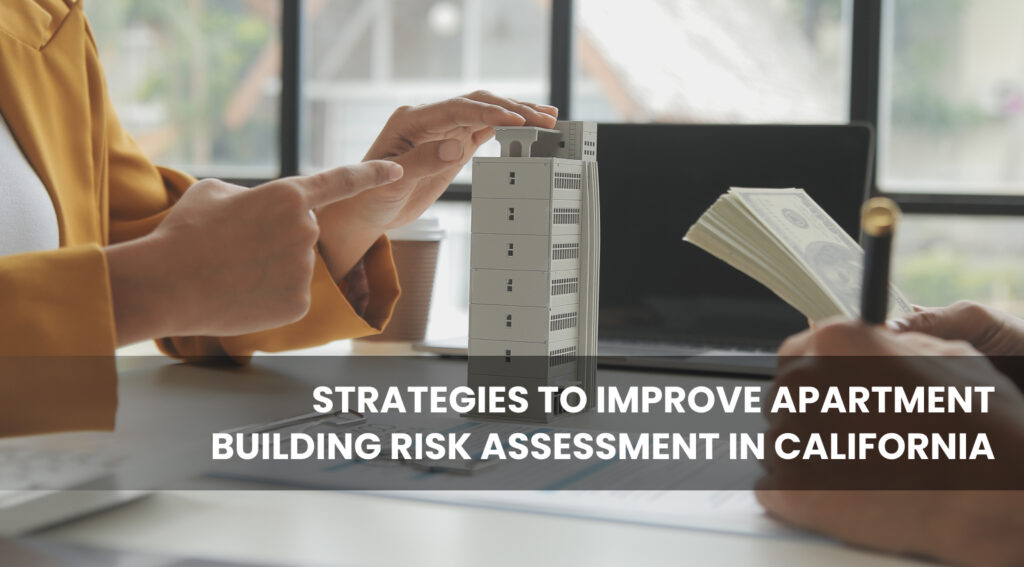
Strategies to Improve Apartment Building Risk Assessment in California
Improving risk assessment for California apartment building owners and managers entails going above and beyond the bare minimum of safety precautions. The best practices include thorough apartment insurance in California, regular property inspections, compliance with California fire and earthquake regulations, stringent tenant screening, and modern security systems. All of these actions work together to lower risks, save expenses, and guarantee more efficient claims processing.
Why Risk Assessment Matters for Apartment Buildings in California
In California, apartment buildings are exposed to a special combination of hazards, including water damage, wildfires, earthquakes, liabilities incurred by tenants, and problems with state housing regulations. Inadequate risk management can result in increased insurance costs, legal action, or rejected claims.
Strategic risk assessment is useful in this situation. Property owners can reduce insurance costs, protect tenants, and preserve long-term investment value by proactively identifying and fixing vulnerabilities.
The Essential Techniques for Enhancing Risk Assessment
1. Conduct Routine Inspections
Think of inspections as your building’s health checkups. Look for leaky pipes, frayed wires, and anything that might make your insurance company sigh heavily. Catch issues early, and avoid the “why didn’t anyone see this coming?” moment.
2. Fire & Earthquake Preparedness
California says: “Be ready.” Smoke alarms, sprinklers, fire-resistant landscaping, and seismic retrofits aren’t just safety measures; they’re also premium savers.
3. Strengthen Tenant Screening
While not all tenants cause problems, some do. Background checks, rental histories, and credit checks help you avoid lawsuit dramas and nightmares related to property damage.
4. Improve Security Protocols
Smart locks and a few CCTV cameras can deter burglaries and make you appear superhuman to your insurance company.
5. Make Use of Policies for Apartment Insurance, California
Insurance is a strategy, not just a life insurance policy. Customized apartment insurance in California protects against property damage, liability claims, and business interruption. Your building deserves a policy that understands California chaos.
Key Risks vs. Mitigation Strategies
| Risk Factor | Potential Loss | Risk Mitigation Strategy |
| Earthquake Damage | Cracked walls, tenant evacuation drama | Seismic retrofitting, earthquake coverage add-ons |
| Fire Hazards | Property loss, heroic evacuation stories | Fire alarms, sprinklers, fire-resistant landscaping |
| Tenant-Related Liabilities | Lawsuits, property mayhem | Strong tenant screening, lease compliance |
| Theft & Vandalism | Broken locks, lost stuff | CCTV, secure access systems, neighborhood watch |
| Water Damage (plumbing) | Mold, soggy carpets | Routine plumbing checks, water sensors |
Benefits of Strong Risk Assessment for Apartment Insurance
| Benefit | How It Impacts Insurance |
| Lower Premiums | Fewer claims = insurer smiles = lower costs |
| Faster Claims Process | Documented assessments streamline claim approvals |
| Better Coverage Options | Insurers reward proactive, responsible owners |
| Increased Property Value | Low-risk, well-maintained buildings attract tenants & buyers |
| Tenant Safety & Satisfaction | Safe tenants stay longer, happy tenants sing your praises |
Endnote
Risk assessment is not a one-time "tick the box" exercise, but rather an ongoing habit. Your property is safe, your tenants are satisfied, and your pocketbook remains intact thanks to inspections, preparedness for emergencies, smart security, and customized insurance.
We at e360 Insurance Services are experts in California apartment insurance and can help you minimize expenses while safeguarding your assets.
Don't wait for mayhem to break out. Contact e360 Insurance Services today for more intelligent, California-ready apartment insurance options and get a free quote.
